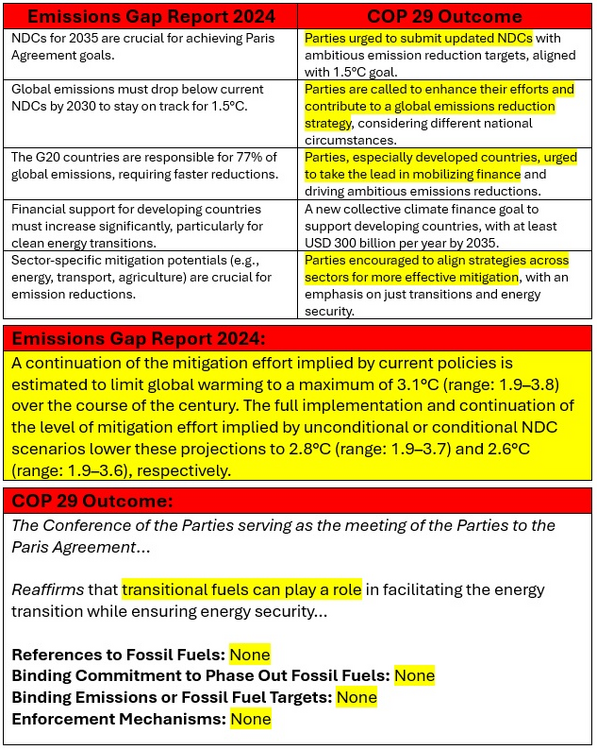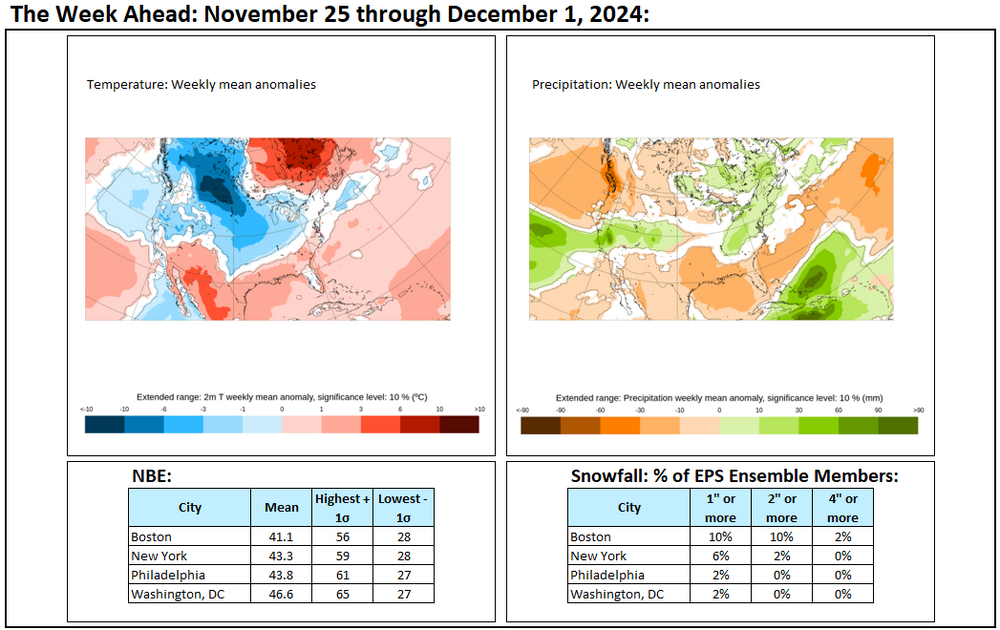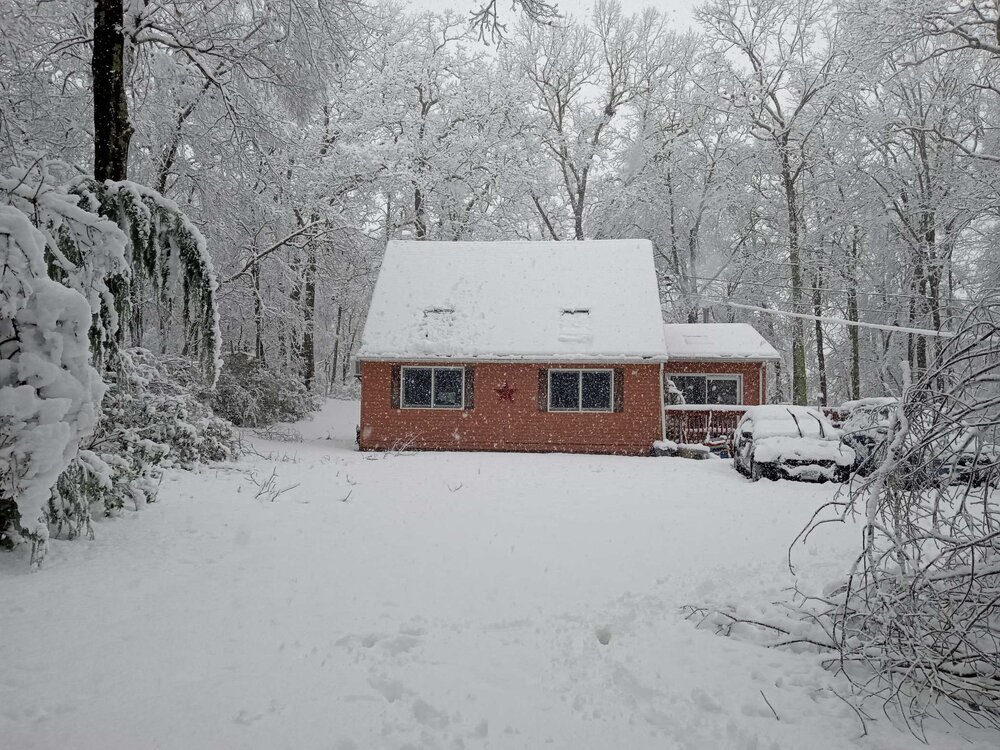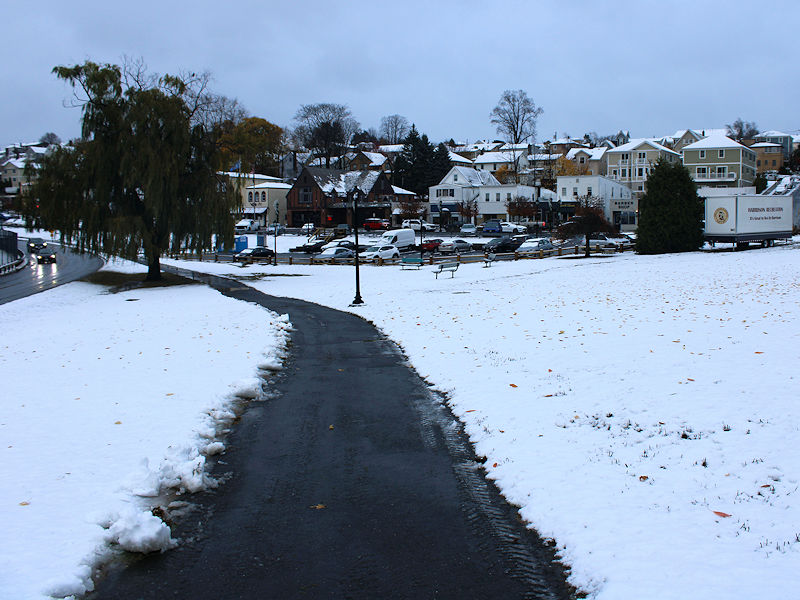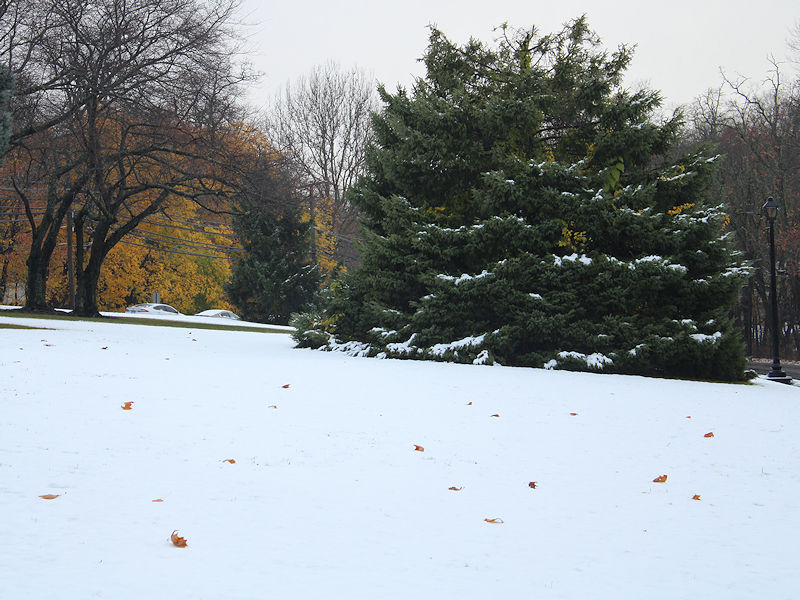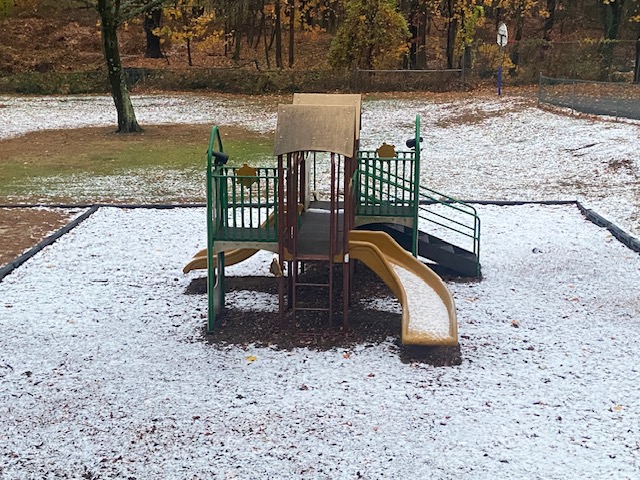-
Posts
22,899 -
Joined
Content Type
Profiles
Blogs
Forums
American Weather
Media Demo
Store
Gallery
Everything posted by donsutherland1
-
A cooler pattern is now in its early stages of developing. Rain will arrive late tonight. The rain will continue into tomorrow night. Some of the distant northern and western suburbs could see some snow mix in. A general 0.50"-1.00" rainfall is likely. Colder air will begin to move into the region following the Thanksgiving Day storm. On account of successive waves of cold, the first two weeks of December will likely feature mainly below normal temperatures. The long-range guidance remains in good agreement for a cold first half of December. Significant lake effect snow is likely. The NAO fell to a preliminary -2.751 on September 24th (all-time September record: -2.371, September 12, 1971). That was the 9th lowest value on record. La Niña winters following September cases where the NAO fell to -1.900 or below featured a predominantly positive NAO. The most recent such winters were 2016-2017 and 2022-2023. The mean temperatures for those winters in New York City were 39.3° and 41.0° respectively. The 1991-2020 normal value is 36.2°. A warmer to much warmer than normal outcome is favored by the November run of the ECMWF for Winter 2024-2025. The ENSO Region 1+2 anomaly was +0.8°C and the Region 3.4 anomaly was -0.1°C for the week centered around November 20. For the past six weeks, the ENSO Region 1+2 anomaly has averaged 0.00°C and the ENSO Region 3.4 anomaly has averaged -0.23°C. Neutral ENSO conditions may still evolve into a La Niña event during the winter. Uncertainty as to whether a La Niña will actually develop continues to increase. The SOI was +21.06 today. The preliminary Arctic Oscillation (AO) was +0.187 today. Based on sensitivity analysis applied to the latest guidance, there is an implied near 100% probability that New York City will have a warmer than normal November (1991-2020 normal). November will likely finish with a mean temperature near 51.4° (3.4° above normal). November 2024 will be the third November since 2020 with a monthly mean temperature of 50° or above.
-
In theory, yes. But a lot would have to happen for such a pattern to actually develop.
-
A cooler pattern is now imminent. It will turn cooler and increasingly cloudy tomorrow. Rain will arrive late tomorrow night or Thursday morning. The rain will continue into Thursday night. Distant northern and western suburbs could see some snow mix in. Colder air will begin to move into the region following the Thanksgiving Day storm. On account of successive waves of cold, the first two weeks of December will likely feature mainly below normal temperatures. The long-range guidance is in good agreement for a cold first half of December. Significant lake effect snow is possible. The NAO fell to a preliminary -2.751 on September 24th (all-time September record: -2.371, September 12, 1971). That was the 9th lowest value on record. La Niña winters following September cases where the NAO fell to -1.900 or below featured a predominantly positive NAO. The most recent such winters were 2016-2017 and 2022-2023. The mean temperatures for those winters in New York City were 39.3° and 41.0° respectively. The 1991-2020 normal value is 36.2°. A warmer to much warmer than normal outcome is favored by the November run of the ECMWF for Winter 2024-2025. The ENSO Region 1+2 anomaly was +0.8°C and the Region 3.4 anomaly was -0.1°C for the week centered around November 20. For the past six weeks, the ENSO Region 1+2 anomaly has averaged 0.00°C and the ENSO Region 3.4 anomaly has averaged -0.23°C. Neutral ENSO conditions may still evolve into a La Niña event during the winter. Uncertainty as to whether a La Niña will actually develop continues to increase. The SOI was +24.37 today. The preliminary Arctic Oscillation (AO) was +1.555 today. Based on sensitivity analysis applied to the latest guidance, there is an implied near 100% probability that New York City will have a warmer than normal November (1991-2020 normal). November will likely finish with a mean temperature near 51.2° (3.2° above normal).
-
It was a cold winter. The highlight was late December into early January, which featured extreme cold. NYC saw the temperature fall to -1° on December 25th.
-
Tomorrow will be the warmest day of the week and likely for some time to come. Temperatures will top out in the middle and perhaps upper 50s, even as showers and a period of rain are likely. A storm will bring additional rain on Thursday into Thursday night. Colder air will begin to move into the region following the Thanksgiving Day storm. On account of successive waves of cold, the first two weeks of December will likely feature mainly below normal temperatures. The long-range guidance is in good agreement for a cold first half of December. Significant lake effect snow is possible. The NAO fell to a preliminary -2.751 on September 24th (all-time September record: -2.371, September 12, 1971). That was the 9th lowest value on record. La Niña winters following September cases where the NAO fell to -1.900 or below featured a predominantly positive NAO. The most recent such winters were 2016-2017 and 2022-2023. The mean temperatures for those winters in New York City were 39.3° and 41.0° respectively. The 1991-2020 normal value is 36.2°. A warmer to much warmer than normal outcome is favored by the November run of the ECMWF for Winter 2024-2025. The ENSO Region 1+2 anomaly was +0.8°C and the Region 3.4 anomaly was -0.1°C for the week centered around November 20. For the past six weeks, the ENSO Region 1+2 anomaly has averaged 0.00°C and the ENSO Region 3.4 anomaly has averaged -0.23°C. Neutral ENSO conditions may still evolve into a La Niña event during the winter. Uncertainty as to whether a La Niña will actually develop continues to increase. The SOI was +17.62 today. The preliminary Arctic Oscillation (AO) was +1.120 today. Based on sensitivity analysis applied to the latest guidance, there is an implied near 100% probability that New York City will have a warmer than normal November (1991-2020 normal). November will likely finish with a mean temperature near 51.0° (3.0° above normal).
-
I suspect that the strengthening PV and lagged response to the development of an AO+/NAO+ will increase the risk for warming late in December. It will take some time to scour out the cold that will dominate during the first half of the month, especially when the PNA is positive.
-
I agree with his assessment. The MJO is currently in Phase 3 at a high amplitude. As it moves into and through the Maritime Continent, one would generally expect warmth in the East. The MJO's impact can be offset by other variables.
-
Even if the two-thirds or so of December is cold, there is no assurance that the pattern would lock in. Indeed, I suspect that it will begin to transition toward a milder pattern around the Solstice. Even very cold Decembers have been followed by generally mild conditions during the rest of the winter.
-
Currently, 7 of the 9 statistical models and 9 of the 17 dynamical models are forecasting neutral ENSO conditions for the winter. Over the past 6 weeks, the Region 3.4 anomaly has averaged -0.23°C. The latest weekly figure for the week centered around November 20th is -0.1°C.
-
Tomorrow and Tuesday will be the warmest days of the week and likely for some time to come. Temperatures will top out in the middle and perhaps upper 50s, especially on Tuesday. Afterward colder air will begin to move into the region. On account of successive waves of cold, the first two weeks of December will likely feature mainly below normal temperatures. The long-range guidance is in good agreement for a cold first half of December. Significant lake effect snow is possible. The NAO fell to a preliminary -2.751 on September 24th (all-time September record: -2.371, September 12, 1971). That was the 9th lowest value on record. La Niña winters following September cases where the NAO fell to -1.900 or below featured a predominantly positive NAO. The most recent such winters were 2016-2017 and 2022-2023. The mean temperatures for those winters in New York City were 39.3° and 41.0° respectively. The 1991-2020 normal value is 36.2°. A warmer to much warmer than normal outcome is favored by the November run of the ECMWF for Winter 2024-2025. The ENSO Region 1+2 anomaly was +0.2°C and the Region 3.4 anomaly was 0.0°C for the week centered around November 13. For the past six weeks, the ENSO Region 1+2 anomaly has averaged -0.20°C and the ENSO Region 3.4 anomaly has averaged -0.30°C. Neutral ENSO conditions may evolve into a La Niña event during the late fall. Uncertainty as to whether a La Niña will develop has increased. The SOI was +21.82 today. The preliminary Arctic Oscillation (AO) was +0.130 today. Based on sensitivity analysis applied to the latest guidance, there is an implied near 100% probability that New York City will have a warmer than normal November (1991-2020 normal). November will likely finish with a mean temperature near 50.9° (2.9° above normal).
-
Five thoughts on the upcoming colder pattern triggered by a developing EPO block and forecast AO-/PNA+ pattern: 1. The first half of December looks cold in much of the East. A one-week period with a temperature anomaly of 6°-10° below normal is plausible. 2. Initially snowfall options could be limited due to the source region of the air masses. It remains to be seen whether the recent rainfall in the East and the upcoming storm to the Great Lakes region later this week were exceptions rather than the beginning of the end of the ongoing drought in the Northeast. Until a persistently wetter pattern emerges, my operating assumption remains that the drought will persist. That raises the bar for big snowfall events even as cold should be sufficient to allow for opportunities through at least the first half of December. The Great Lakes region and LES belts should be in good shape. For snowfall, I'd rather be in such cities as Chicago, Detroit, Buffalo and Toronto than Philadelphia, New York City, or Boston. 3. In most cases following exceptional November warmth and a colder first half of December, the second half of the month was not much warmer than normal. Therefore, the odds are now tilted toward a cooler than normal December in the eastern third of the U.S. including such cities as Philadelphia, New York City, Buffalo, Chicago, Detroit, and Indianapolis, among others. Toronto could also wind up colder than normal. 4. The long-range guidance might rush the break in the colder pattern. I suspect that timing closer to the winter solstice than mid-month might be more realistic for the onset of any pattern change. 5. These developments do not necessarily mean that winter won't be warmer than normal as per the seasonal guidance (the seasonal guidance usually does better with three month assessments than month-to-month ones). They do reinforce the idea that the coming winter won't be as abnormally warm as the last two winters have been. A potential wildcard remains ENSO. The probability of a full-fledged La Niña event (tri-monthly average) has decreased. A neutral-cold outcome remains possible. The relative ENSO Index (RONI) will be consistent with La Niña.
-

Occasional Thoughts on Climate Change
donsutherland1 replied to donsutherland1's topic in Climate Change
2024 remains on track to become the hottest year on record on all of the major climate data sets. To avoid setting a new record, November 23-December 31 would have to see global temperatures that were last seen in 2000. Climate change played a major role in the exceptional heat in the Sahel region in April, the April-May heat in Asia, the sustained extreme heat in Mexico during May and June, the Mediterranean heatwave in July, and the unprecedented autumn heatwave in the Southwestern United States. The 2024 emissions gap report revealed that the world remains on track for 2.6°C-3.1°C warming by 2100. It's cover pleaded with those who would gather for COP 29, "No more hot air...please!" If one wondered what inaction would look like, one saw it at COP 29. The conference, which featured some late-moment drama, was as close to a total failure as it could have been. Despite spin coming from some quarters that it made at least some progress, the reality is that it made no progress. Instead of agreements, declarations, or binding commitments, nations were urged, called upon or encouraged to act. No mention of fossil fuels, responsible for the climate-warming greenhouse gas pollution, was made in any of the four concluding documents. Instead, in an act of cynicism borrowed from COP 28, "transitional fuels," meaning such fossil fuels as natural gas, were embraced as helpful for the "energy transition." Perhaps in the insular world of COP 29, the participants believe rhetoric alone is sufficient to address problems. Just maybe, they believe that one can simply wish away anthropogenic climate change. Outside COP 29, there is broad consensus that credible goals and commitments are specific and measurable. They come with clear targets to guide progress. The most effective ones come with mechanisms to address gaps, be they cost overruns or production shortfalls, when they arise. None of these attributes made it into any of the four COP 29 documents. If anything, COP 29 delivered the last rites for the Paris Goal of holding warming to no more than 1.5°C. Below is a summary of the failed COP 29 conference. -
A colder pattern will begin to settle in over the next week. But snowfall prospects for the big cities of the East will remain low. Interior sections, especially the lake effect belt, central/upstate New York into central and northern New England could see a moderate or significant snowfall.
-
Tomorrow will see temperature begin to turn milder with the temperature reaching 50° or somewhat higher. Monday and Tuesday will be the warmest days. Temperatures will top out in the middle and perhaps upper 50s. Afterward colder air will begin to move into the region. On account of successive waves of cold, the first two weeks of December will likely feature mainly below normal temperatures. The long-range guidance is in good agreement for a cold first half of December. The NAO fell to a preliminary -2.751 on September 24th (all-time September record: -2.371, September 12, 1971). That was the 9th lowest value on record. La Niña winters following September cases where the NAO fell to -1.900 or below featured a predominantly positive NAO. The most recent such winters were 2016-2017 and 2022-2023. The mean temperatures for those winters in New York City were 39.3° and 41.0° respectively. The 1991-2020 normal value is 36.2°. A warmer to much warmer than normal outcome is favored by the November run of the ECMWF for Winter 2024-2025. The ENSO Region 1+2 anomaly was +0.2°C and the Region 3.4 anomaly was 0.0°C for the week centered around November 13. For the past six weeks, the ENSO Region 1+2 anomaly has averaged -0.20°C and the ENSO Region 3.4 anomaly has averaged -0.30°C. Neutral ENSO conditions may evolve into a La Niña event during the late fall. Uncertainty as to whether a La Niña will develop has increased. The SOI was +19.02 today. The preliminary Arctic Oscillation (AO) was -0.658 today. Based on sensitivity analysis applied to the latest guidance, there is an implied 99% probability that New York City will have a warmer than normal November (1991-2020 normal). November will likely finish with a mean temperature near 51.0° (3.0° above normal).
-
Overnight, colder air rushed into the region. Rain changed to wet snow for a time even in nearby suburbs where there was a slushy coating of snow in many places. White Plains picked up 2" of snow. The highest amount in the region was 20.0" at High Point, NJ, but that figure was from 8:30 am. The departing storm will likely be followed by a short period of below normal but not exceptionally cold temperatures before it turns milder early next week. A stronger shot of cold could arrive late in the month. The first week of December will likely feature generally below normal temperatures. The NAO fell to a preliminary -2.751 on September 24th (all-time September record: -2.371, September 12, 1971). That was the 9th lowest value on record. La Niña winters following September cases where the NAO fell to -1.900 or below featured a predominantly positive NAO. The most recent such winters were 2016-2017 and 2022-2023. The mean temperatures for those winters in New York City were 39.3° and 41.0° respectively. The 1991-2020 normal value is 36.2°. A warmer to much warmer than normal outcome is favored by the November run of the ECMWF for Winter 2024-2025. The ENSO Region 1+2 anomaly was +0.2°C and the Region 3.4 anomaly was 0.0°C for the week centered around November 13. For the past six weeks, the ENSO Region 1+2 anomaly has averaged -0.20°C and the ENSO Region 3.4 anomaly has averaged -0.30°C. Neutral ENSO conditions may evolve into a La Niña event during the late fall. Uncertainty as to whether a La Niña will develop has increased. The SOI was +12.40 today. The preliminary Arctic Oscillation (AO) was -0.976 today. Based on sensitivity analysis applied to the latest guidance, there is an implied 97% probability that New York City will have a warmer than normal November (1991-2020 normal). November will likely finish with a mean temperature near 51.2° (3.2° above normal).
-
Discussion New York City has seen its biggest rainfall since August 18th when 2.29" fell. Periods of rain will continue overnight and through much of tomorrow. The rain will likely end as a period of wet snow or flurries on Friday morning in the distant northern and western suburbs, especially hilly sections where some accumulations are possible. A heavy wet snowfall is likely in the higher elevations of the Catskills and Poconos. The departing storm will likely be followed by a period of below normal but not exceptionally cold temperatures. A stronger shot of cold could arrive to end the month or start December. The first week of December will likely feature generally below normal temperatures. The NAO fell to a preliminary -2.751 on September 24th (all-time September record: -2.371, September 12, 1971). That was the 9th lowest value on record. La Niña winters following September cases where the NAO fell to -1.900 or below featured a predominantly positive NAO. The most recent such winters were 2016-2017 and 2022-2023. The mean temperatures for those winters in New York City were 39.3° and 41.0° respectively. The 1991-2020 normal value is 36.2°. A warmer to much warmer than normal outcome is favored by the November run of the ECMWF for Winter 2024-2025. The ENSO Region 1+2 anomaly was +0.2°C and the Region 3.4 anomaly was 0.0°C for the week centered around November 13. For the past six weeks, the ENSO Region 1+2 anomaly has averaged -0.20°C and the ENSO Region 3.4 anomaly has averaged -0.30°C. Neutral ENSO conditions may evolve into a La Niña event during the late fall. Uncertainty as to whether a La Niña will develop has increased. The SOI was +14.12 today. The preliminary Arctic Oscillation (AO) was -1.097 today. Based on sensitivity analysis applied to the latest guidance, there is an implied 98% probability that New York City will have a warmer than normal November (1991-2020 normal). November will likely finish with a mean temperature near 51.4° (3.4° above normal).
-

Occasional Thoughts on Climate Change
donsutherland1 replied to donsutherland1's topic in Climate Change
I have seen no information about specific impacts. I suspect follow-up research will aim to provide more insight into regional impacts. -
The 1z NBE shows 1.1" snow for New York City on Friday with a daily minimum temperature of 38°. If that winds up being the low, the odds are very strongly against measurable snowfall, even if some snow mixes with the rain. Below is the historic data:
-
A soaking rain will arrive overnight. The rain will likely continue into Friday morning with the heaviest rainfall occurring overnight into tomorrow morning. A general 1.00"-2.00" rainfall with some locally higher amounts is likely. The rain will likely as a period of wet snow or flurries on Friday morning in the distant northern and western suburbs, especially hilly sections where some accumulations are possible. That rain will likely be followed by a period of below normal but not exceptionally cold temperatures. A stronger shot of cold could arrive to end the month or start December. The first week of December could feature generally below normal temperatures. The NAO fell to a preliminary -2.751 on September 24th (all-time September record: -2.371, September 12, 1971). That was the 9th lowest value on record. La Niña winters following September cases where the NAO fell to -1.900 or below featured a predominantly positive NAO. The most recent such winters were 2016-2017 and 2022-2023. The mean temperatures for those winters in New York City were 39.3° and 41.0° respectively. The 1991-2020 normal value is 36.2°. A warmer to much warmer than normal outcome is favored by the November run of the ECMWF for Winter 2024-2025. The ENSO Region 1+2 anomaly was +0.2°C and the Region 3.4 anomaly was 0.0°C for the week centered around November 13. For the past six weeks, the ENSO Region 1+2 anomaly has averaged -0.20°C and the ENSO Region 3.4 anomaly has averaged -0.30°C. Neutral ENSO conditions may evolve into a La Niña event during the late fall. Uncertainty as to whether a La Niña will develop has increased. The SOI was +16.99 today. The preliminary Arctic Oscillation (AO) was -1.706 today. Based on sensitivity analysis applied to the latest guidance, there is an implied 98% probability that New York City will have a warmer than normal November (1991-2020 normal). November will likely finish with a mean temperature near 51.5° (3.5° above normal).
-
It will mild tomorrow with temperatures topping out mainly in the middle and upper 50s. The dry weather will continue through most of tomorrow. Rain is likely late tomorrow night into Friday morning. Models have grown wetter in recent cycles. A storm total of 1.00"-2.00" is likely with a few locally higher amounts. There is a chance that distant northern and western suburbs, especially hilly sections, could see the rain end as a period of wet snow or flurries. That rain will likely be followed by a period of below normal but not exceptionally cold temperatures. The NAO fell to a preliminary -2.751 on September 24th (all-time September record: -2.371, September 12, 1971). That was the 9th lowest value on record. La Niña winters following September cases where the NAO fell to -1.900 or below featured a predominantly positive NAO. The most recent such winters were 2016-2017 and 2022-2023. The mean temperatures for those winters in New York City were 39.3° and 41.0° respectively. The 1991-2020 normal value is 36.2°. A warmer to much warmer than normal outcome is favored by the November run of the ECMWF for Winter 2024-2025. The ENSO Region 1+2 anomaly was +0.2°C and the Region 3.4 anomaly was 0.0°C for the week centered around November 13. For the past six weeks, the ENSO Region 1+2 anomaly has averaged -0.20°C and the ENSO Region 3.4 anomaly has averaged -0.30°C. Neutral ENSO conditions may evolve into a La Niña event during the late fall. Uncertainty as to whether a La Niña will develop has increased. The SOI was +15.46 today. The preliminary Arctic Oscillation (AO) was -1.178 today. Based on sensitivity analysis applied to the latest guidance, there is an implied 97% probability that New York City will have a warmer than normal November (1991-2020 normal). November will likely finish with a mean temperature near 51.5° (3.5° above normal).
-
It will turn somewhat cooler tomorrow with temperatures topping out mainly in the middle 50s. The dry weather will continue through the middle of the week. Rain is likely Wednesday night and Thursday. A storm total of 0.50"-1.00" is likely with some locally higher amounts of 1.50". That rain will likely be followed by a period of below normal but not exceptionally cold temperatures. With the remainder of November potentially becoming mainly dry following the rainstorm, parts of the region could challenge records for their driest fall and driest season on record. Select records are below: New York City: Driest fall: 4.00", Fall 1908; Driest season: 3.92", Summer 1999 Newark: Driest fall: 4.21", Fall 1931; Driest season: 4.21", Fall 1931 Philadelphia: Driest fall: 2.37", Fall, 1922; Driest season: 2.37", Fall 1922 Wilmington, DE: Driest fall: 3.17", Fall 1922; Driest season: 3.17", Fall 1922 The NAO fell to a preliminary -2.751 on September 24th (all-time September record: -2.371, September 12, 1971). That was the 9th lowest value on record. La Niña winters following September cases where the NAO fell to -1.900 or below featured a predominantly positive NAO. The most recent such winters were 2016-2017 and 2022-2023. The mean temperatures for those winters in New York City were 39.3° and 41.0° respectively. The 1991-2020 normal value is 36.2°. A warmer to much warmer than normal outcome is favored by the November run of the ECMWF for Winter 2024-2025. The ENSO Region 1+2 anomaly was +0.2°C and the Region 3.4 anomaly was 0.0°C for the week centered around November 13. For the past six weeks, the ENSO Region 1+2 anomaly has averaged -0.20°C and the ENSO Region 3.4 anomaly has averaged -0.30°C. Neutral ENSO conditions may evolve into a La Niña event during the late fall. Uncertainty as to whether a La Niña will develop has increased. The SOI was +9.29 today. The preliminary Arctic Oscillation (AO) was +0.012 today. Based on sensitivity analysis applied to the latest guidance, there is an implied 96% probability that New York City will have a warmer than normal November (1991-2020 normal). November will likely finish with a mean temperature near 51.4° (3.4° above normal).
-
Tomorrow will be another mild day with temperatures topping out in the lower to perhaps middle 60s across much of the region. The dry weather will continue through the middle of the week. Rain is likely Wednesday night and Thursday. The potential exists for 0.50"-1.50" of rain. That rain will likely be followed by a period of below normal but not exceptionally cold temperatures. With the remainder of November potentially becoming mainly dry following the rainstorm, parts of the region could challenge records for their driest fall and driest season on record. Select records are below: New York City: Driest fall: 4.00", Fall 1908; Driest season: 3.92", Summer 1999 Newark: Driest fall: 4.21", Fall 1931; Driest season: 4.21", Fall 1931 Philadelphia: Driest fall: 2.37", Fall, 1922; Driest season: 2.37", Fall 1922 Wilmington, DE: Driest fall: 3.17", Fall 1922; Driest season: 3.17", Fall 1922 The NAO fell to a preliminary -2.751 on September 24th (all-time September record: -2.371, September 12, 1971). That was the 9th lowest value on record. La Niña winters following September cases where the NAO fell to -1.900 or below featured a predominantly positive NAO. The most recent such winters were 2016-2017 and 2022-2023. The mean temperatures for those winters in New York City were 39.3° and 41.0° respectively. The 1991-2020 normal value is 36.2°. A warmer to much warmer than normal outcome is favored by the November run of the ECMWF for Winter 2024-2025. The ENSO Region 1+2 anomaly was -0.2°C and the Region 3.4 anomaly was -0.3°C for the week centered around November 6. For the past six weeks, the ENSO Region 1+2 anomaly has averaged -0.32°C and the ENSO Region 3.4 anomaly has averaged -0.35°C. Neutral ENSO conditions may evolve into a La Niña event during the late fall. The SOI was +8.52 today. The preliminary Arctic Oscillation (AO) was +0.241 today. Based on sensitivity analysis applied to the latest guidance, there is an implied 90% probability that New York City will have a warmer than normal November (1991-2020 normal). November will likely finish with a mean temperature near 51.2° (3.2° above normal).




